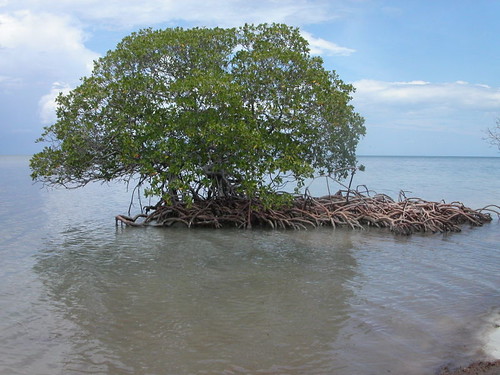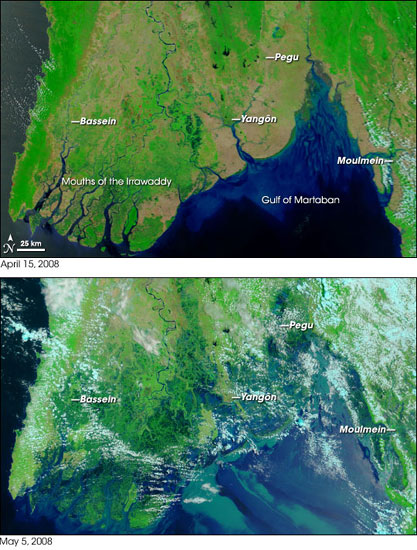tags: Environment, Cyclone Nargis, Myanmar, Burma, Mangrove, Rhizophora species, Shrimp Farming, Fish Farming
Mangrove, Rhizophora species, in Cuba. [larger view].
I've written about the importance of mangrove forests before, and about the environmental disasters and human tragedies that result when they are wantonly destroyed. Unfortunately, as we are witnessing now, the widespread destruction of Burma's mangroves has magnified yet another human disaster in the wake of cyclone Nargis, a tragedy that might have claimed more than 100,000 lives, according to some news services' estimates.
"Encroachment into mangrove forests, which used to serve as a buffer between the rising tide, between big waves and storms and residential areas; all those lands have been destroyed," said Surin Pitsuwan, secretary-general for the Association of South-East Asian Nations (ASEAN).
Even though Cyclone Nargis was a strong storm, with winds clocked at 190km/h (120mph), it was the storm's surge that caused the most damage and death.
"The wave was up to 12 feet (3.5 meters) high and it swept away and inundated half the houses in low-lying villages," said Burma's minister for relief and resettlement, Maung Maung Swe. "They did not have anywhere to flee."
Images from a NASA satellite show the impact of Cyclone Nargis on southern Burma. Before it hit, on 15 April (top image), features are sharply defined. In the aftermath on 5 May (bottom image), much of the Irrawaddy river delta region is clearly flooded.
Mangroves are a group of salt-tolerant evergreens that grow in tropical and subtropical areas where ever marine and fresh water meet; coastlines, deltas and rivers. Mangroves form a dense forest with an extensive root system that buffers residential areas and farms against the effects of storms, tsunamis, freak ocean waves and rising tides. However, mangroves are under pressure from humans who eagerly rip them out and replace them with shrimp and fish farms, as seen throughout southeast Asia and other coastal regions of the world.
Unfortunately, Burma's mangroves suffered as a result of being overexploited. A recent United Nations Food and Agriculture Organization (FAO) study reported that 3.6 million hectares (35%) of all mangrove forests were destroyed since 1980. The study also pointed out that Asia had suffered the greatest loss, with the destruction of more than 1.9 million hectares.
"There are very limited areas that you would describe as pristine or densely covered mangrove in the Irrawaddy area," said Mette Wilkie, a senior forestry officer for the FAO, referring to the region of Burma where Cyclone Nagris first made landfall.
These mangroves were replaced with fish and shrimp farms, and were also destroyed to meet the demands of tourism and of large populations of people living along coastlines.
"The impact is so severe because of the increase of the population," observed Pitsuwan.
As I found in early 2005 when I was writing about the tsunami that killed roughly 200,000 people (more than half of them in Indonesia alone);
The protective qualities of mangroves were .. observed in 1999 when a cyclone in the Bay of Bengal claimed more than 10,000 lives and washed away several coastal villages in the state of Orissa on India's eastern coast. This was one of the worst cyclones in history with winds of 160 miles per hour. However, amidst all the damages, it was noted that villages in and around neighboring Bhitarkanika were spared much of the cyclone's fury: Bhitarkanika is the second largest mangrove forest in India. [ref].
This cyclone was a terrible event, but the needless loss of mangroves worsened the cost in human lives lost and widespread damage to property and much-needed agricultural areas. We not only need to help the thousands of survivors in their time of need, but we also must help replant the mangroves in Burma and elsewhere to prevent tragedies that will inevitably occur in the future.
Sources
BBCNews (quotes)
Mangroves and Tsunamis: The Shrimp Connection -- Lots of background!
- Log in to post comments



Nicely said.
I don't see that what you've blogged here justifies the title of the blog: "Mangrove Destruction Magnified Burmese Tragedy"!
Yes, we're destroying important parts of the natural world, but as Pitsuwan observed, "The impact is so severe because of the increase of the population" - not because the mangroves were gone.
The impact was awful because large numbers of people lived on the coast and because they had no warning. I don't see that even if all the mangroves had been left in place, they would have stopped a 12 foot storm surge from doing what it did.
Which part of the destruction was magnified because the mangroves had been hacked down?
Ian,
Please read http://books.google.co.uk/books?id=dPLzt5uyNAcC&pg=PA345&lpg=PA345&dq=m…
Mangrove helps mitigate tidal surges by absorbing the force of the waves, similar to bullrushes in rivers.
So without the mangroves the full force of the surge is unleashed on the low lying coastal plains and can travel further inland.
Chris -
Your reference was to a book which involved digging through a score of pages in small print to try find the possible reference you want me to look at. I'll look again when I have time.
It seems like all the articles I've read on this matter have someone say words to the effect: "it wouldn't have been as bad if the mangroves had been preserved", but no one offers any actual support for this claim.
OTOH, we have articles like this:
http://news.xinhuanet.com/english/2007-11/17/content_7093869.htm
which show that even where mangroves were in place, the surge killed in large numbers, so I think my question still stands: was it the lack of mangroves or was it more likely that thousands of people lived on the coast and had no warning?
I think the issue is accented by Patsuwan's comment that an increase in the coastal population was the root cause. Whether the mangroves would have mitigated this in view of that situation is what's at issue in my mind.
Ian,
Apologies for the font size in the book, it was the only online version I could find.
The links below are to other sites discussing the mitigation effect of mangroves.
The mangroves won't stop the tide/surge/tidal wave but they do absorb a lot of the force.
Similar coastal defences are manmade such as sea walls.
Yes, massive populations on coastal plains adds to the death toll and this is why so many died (same percentage dead so larger population means more affected).
As for warnings. Well, as the plain is kilometeres wide and transport is limited, I'm not sure that would have help much.